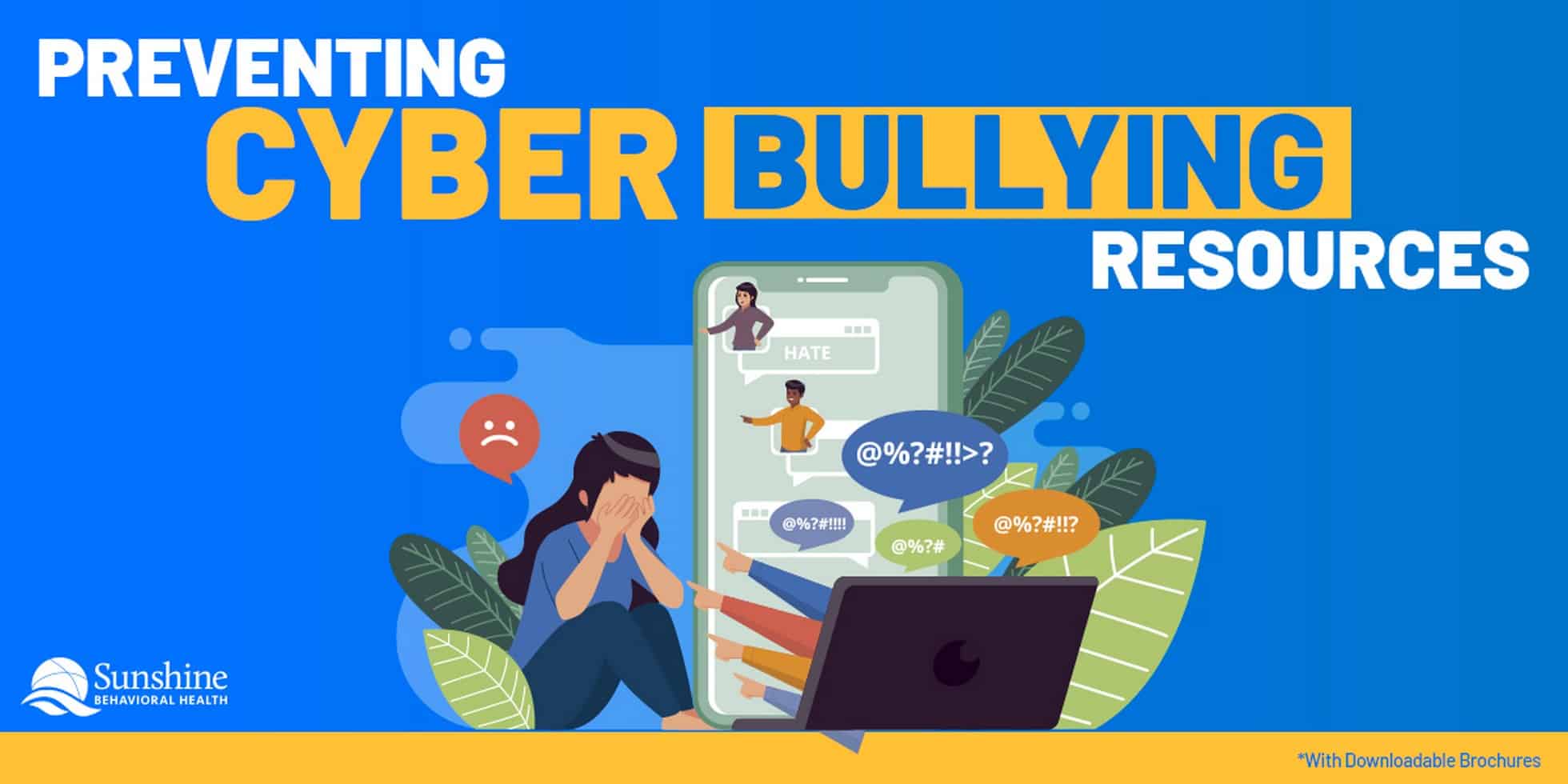Cyberbullying is a problem, but how big or significant a problem remains to be determined.
Its apparent growth may be due to the increased prevalence of electronic devices, the obsession with going online and staying connected, and the awareness that these factors could cause problems, including exacerbating mental health issues such as substance use disorder.
According to some surprising cyberbullying statistics, the rate of the problem may be declining. Statistics from the Centers for Disease Control and Prevention (CDC) show the rate of cyberbullying among high school students was 14.5% in 2017, down from 19% in 2016. But the Cyberbullying Research Center says in 2019, lifetime reports of cyberbullying were 36.5%, an all-time high.
Cyberbullying is a very harmful act that can lead to substance abuse issues, suicide, or poor school performance for bullying victims. At Sunshine Behavioral Health, we help treat substance addiction. Our recovery centers in California, Colorado, Illinois, and Texas regularly help former cyberbullying victims overcome addiction.
What Is Cyberbullying?
Cyberbullying or electronic bullying is bullying that does not happen in person but via electronic devices—laptop or desktop computers, smartphones, tablets—and as much as 92% via online forums and message boards—Facebook, Twitter, Instagram—public or private.
Not every mean thing posted on social media is cyberbullying, just like not every mean or insensitive comment at school or a social gathering qualifies as bullying. The generally agreed-upon legal definition of bullying requires three elements:
- The harm caused by the bully, behavior or words, must be intentional.
- The target must have less real power, physical or psychological, than the bully.
- The harm recurs over time.
Individuals involved in bullying or cyberbullying involvement include bullies, the bullied, and bystanders. Sometimes bullies are themselves bullied, creating another category: bully-victims.
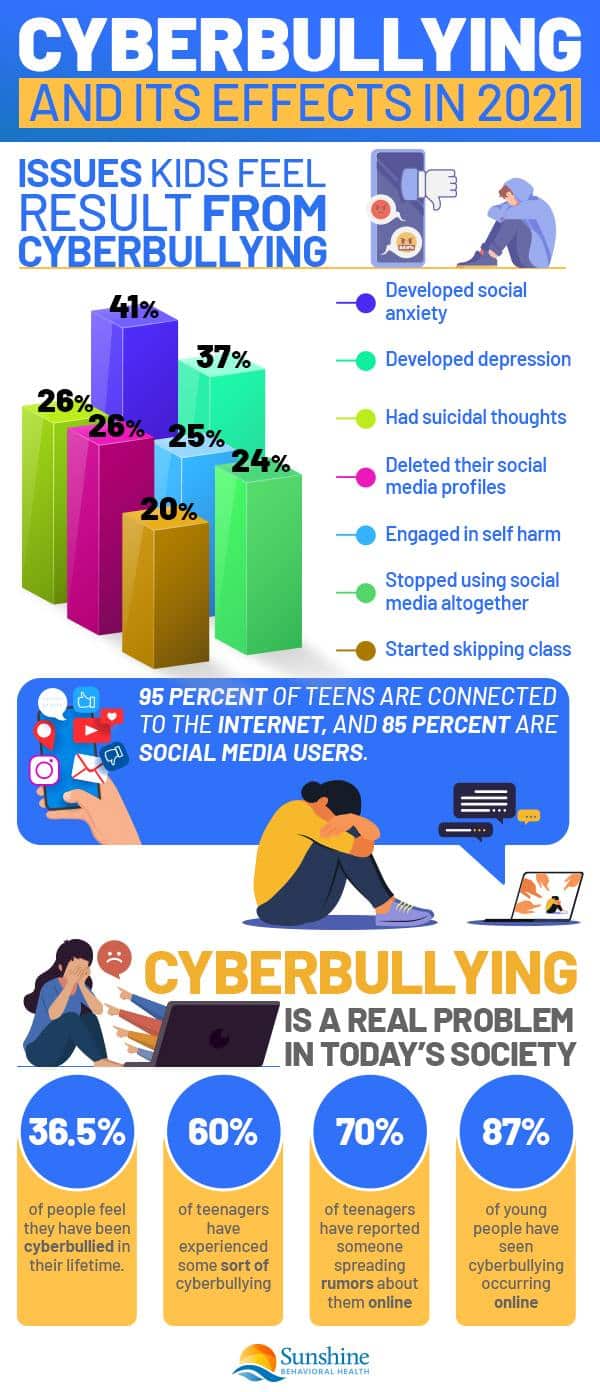
Types of Cyberbullying
There are many types of cyberbullying, including:
- Doxxing (doxing): Publishing personal information of someone without consent, possibly enabling identity theft.
- Outing: Sharing embarrassing or humiliating photos, text messages, or other information of someone without their consent.
- Happy slapping: Attacking someone and circulating embarrassing or damaging photos and videos of the assault.
- Fraping: Impersonating (imping) someone on social media to humiliate them, such as to make them seem racist or homophobic.
- Trickery: Gaining and abusing the trust of someone to get them to reveal embarrassing information.
- Denigrating or dissing: Spreading gossip or rumors about someone.
- Exclusion: Deliberately not informing one group member of a thread, activity, or event invitation.
- Flaming: Hostility directed at one person, such as insults, abusive language, or profanity.
- Cyberstalking. Electronically monitoring the activities and whereabouts of someone, making false accusations, and/or threatening them with physical harm.
- Digital self-harm. As many as 9% of young people admitted to posting cyberbullying messages, hate speech, and death threats about themselves. Some have killed themselves afterward.
Recognizing the Signs of Cyberbullying
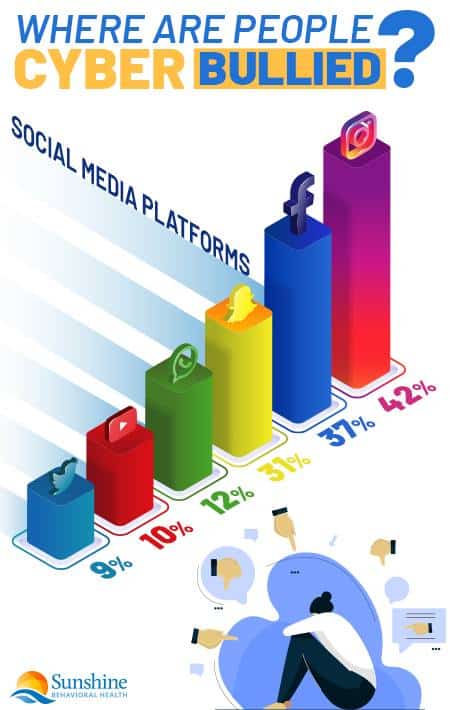 To deal with cyberbullying, people need to know it is taking place. But identifying cyberbullying can be difficult because:
To deal with cyberbullying, people need to know it is taking place. But identifying cyberbullying can be difficult because:
- 80% of cyberbullied teens do not tell anyone, parents or peers, for fear that will brand them a tattletale or a poor sport.
- By itself, cyberbullying does not leave physical signs or scars.
Signs of Cyberbullying
Changes in behavior that might indicate cyberbullying include:
- Sleep problems
- Appearing withdrawn, depressed, angry, or anxious, especially after using an electronic device
- More frequent use of social medial
- Other changes in online behavior
- Declining grades and/or work performance
- Decreased desire to attend school
- Lower self-esteem
Cyberbullying Statistics
Since cyberbullying is so easy to accomplish and avoid the consequences, it must happen more often than traditional bullying, right? Not according to most studies.
According to a 2014 meta-analysis, the rate of traditional bullying involvement was more than twice the rate for cyberbullying (35% to 15%). Other sources put the rate for cyberbullying at 45%, and some others say it is as low as 4.5%.
When only surveying teens, as much as 59% report some form of cyberbullying in one 2018 survey, including:
- 42%: Name-calling
- 32%: False rumors
- 21%: Constantly asking about whereabouts
- 16%: Physical threats
- 7%: Private explicit images shared
That disparity means efforts to fight cyberbullying should not divert resources away from traditional bullying. Instead, the goal should be ending all bullying behaviors, on or offline.
Some of the reasons for these widely diverging numbers may include:
- Most cyberbullying incidents are self-reported.
- Studies often focus on a limited geographic area. Results may be different in other cities, states, nations, or neighborhoods.
- Some studies do not include enough people.
- Different age groups.
More and better research is needed. That includes diversity.
Cyberbullying rates for women are twice as high as for men. For girls, the rates are 2.6 times as high. More than half of women have received unwanted, sexually explicit images electronically.
The cyberbullying rates for LGBTQ or transgender individuals compared to cisgender is also higher, as is the rate for nonwhite over white.
While most of these studies look at cyberbullying among people aged 18 and younger, adults also can bully and be bullied (although it is considered harassment or cyber harassment). One 2021 report found that 41% of American adults experience cyber harassment. Some adults also bully or cyberbully kids.
Who Cyberbullies and Why?
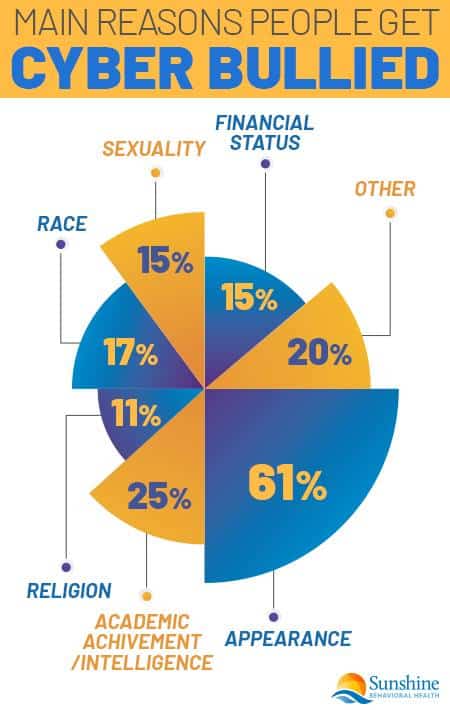 The type of person who becomes a cyberbully varies greatly. As there are many forms of cyberbullying, there are many types of cyberbullies.
The type of person who becomes a cyberbully varies greatly. As there are many forms of cyberbullying, there are many types of cyberbullies.
One common factor among young people is that the bully is seven times more likely to know the bullied person very well—to be a current or former friend or love interest—than to be a stranger. With adults, almost two-thirds of cyber-harassers know their victim.
A 2008 study of freshmen at Bridgewater State College found that 20% admitted to cyberbullying in high school. Their most common motives were:
- Anger or revenge. Female bullies (54%) were more likely to cite this reason than male bullies (38%). StopCyberbullying.org labels people who retaliate for some perceived harm to themselves or friends as vengeful angels.
- Revenge of the nerds. Individuals bullied offline sometimes become cyberbullies themselves to gain power, control, or payback. They are not usually physically strong but often have good computer skills.
- Power-hungry. The online version of the schoolyard bully. They often fill both roles.
- As a joke. Females, 30%; males, 44%. Also known as the inadvertent cyberbully.
- Something to do. Females, 13%; males, 15%. Includes bored so-called mean girls who want to impress their clique.
- Peer pressure. Females and males, 3%.
Some cyberbullies do not see themselves as cyberbullies. They do not realize the harm they can cause or see it as a harmless joke.
Signs That Someone Is a Cyberbully
Parents who suspect that their child is a cyberbully should look for signs, such as:
- A history of bullying or cyberbullying
- A history of being the target of bullies or cyberbullies
- Avoiding discussion of their online activities
- Having multiple active online accounts
- Suspiciously switching screens or closing programs when others approach
If their suspicions turn out to be accurate, parents should not overreact. They will almost certainly need to block all online access—except possibly for schoolwork—for a probationary period, but that should not be the only measure they take.
The parents must find out why and to what extent the cyberbullying took place and ensure that it does not happen again. They should explain why it was wrong. Then, they could require the child to write an essay detailing:
- What they did.
- Why they did it.
- Why now they know it was wrong.
This approach may encourage long-term changes in behavior.
Dangers of Cyberbullying
Almost everybody experiences bullying at some point in their lives. In many cases, being bullied teaches resilience, builds strength, and prepares them for adult life.
Cyberbullying may have worse consequences than traditional bullying, however. While there may also be a physical threat of violence associated with in-person bullying that is not possible in purely electronic bullying, cyberbullying may include other distressing elements that make it hard to avoid, such as:
- It may be anonymous. The bullied do not know who is doing the bullying, making it harder to avoid or gauge the seriousness of the threat.
- It can happen any time, any day. Unlike a school or work bully, who usually only taunts or threatens other individuals when they are in the same place and time, most people now carry smartphones or other electronic devices with them at all times, exposing them to cyberbullying around the clock.
- Its reach can be longer. Social media allows personal data and embarrassing information or photos to be shared instantly. Their friends and family, as well as total strangers, can see them. Once online, it is nearly impossible to completely and permanently remove them. The targets may not even know about such a data dump at first, but it can damage their reputation among prospective employers, dating partners, and others.
Also, it is not always true that words can never hurt us or that what does not kill us makes us stronger. Cyberbullying and online harassment may have severe long-term consequences, such as:
- Bad grades.
- Identity theft.
- Damaged reputations.
- Substance use disorder. In one study, 9% of the cyberbullied begin abusing alcohol and/or drugs. It is important to recognize drug use; like the signs of cocaine use or how to tell if someone is on crystal methamphetamine.
Suicide and Cyberbullying
The worst possible outcome of cyberbullying is that cyberbullied individuals take their own lives. No one knows for sure, however, how much or even if cyberbullying causes suicidal behavior. Both rates have been rising for at least the past decade:
- In 2018, the U.S. tied for the third-highest rate of cyberbullying worldwide.
- In 2019 in the U.S., suicide was the second-leading cause of death across three age groups: people aged 10 to 14, 15 to 24, and 25 to 34 (unintentional injury was the leading cause in each age group).
- One 2018 systematic review in the United Kingdom found that people who were cyberbullied before the age of 25 were twice as likely to commit suicide.
More recent figures indicate that the overall suicide rate in the U.S. decreased 5% from 2019 to 2020, but those provisional results did not look at rates among different age groups.
Regardless of whether there is causation:
- Cyberbullied people are as much as nine times more likely to consider committing suicide.
- The number of young people in hospitals because of suicidal thoughts or attempts doubled between 2008 and 2015.
- The suicide rate doubled for girls ages 15 to 19. The increase in the rate of cyberbullying received some of the blame.
Bullied young people also are more likely to experience depression, anxiety, and low self-esteem, online or offline.
Mental Health Effects of Cyberbullying
There seems to be a link between being bullied, electronically or in person, and those mental health issues such as depression, anxiety, and substance use disorder.
In one study, almost 50% of adolescent psychiatric patients experienced cyberbullying. They also reported higher levels of depressive symptoms. Other studies found that between 5.4% and 11.2% of teens were both bullies and victims.
However, no consensus exists on which problem came first and caused the other. It may be that bullied people suffer mental health issues because of it.
Some bullies may choose victims who already have a mental health disorder, maybe even because they have a mental health disorder.
Targets of cyberbullying often do not tell anyone—friends, family, or teachers—about the cyberbullying. Among adults who have been harassed online, only 39% told anyone, asked for help, or even attempted to resolve the situation themselves.
One common reason cyberbullied teens keep quiet is the fear that their parents will try to protect them by taking away their electronic access.
Cyberbullying and Substance Use Disorder
Regardless of the cause and effect, a 2017 study found that bullying in fifth grade led to more depression in seventh grade and more substance use by 10th grade.
Both bullying and cyberbullying are associated with licit and illicit substance use, alcohol, and drugs. Cyberbullying is associated with psychoactive substance use and problematic internet use too.
One reason could be the self-medication hypothesis, that some people use alcohol and drugs to treat depression, bipolar disorder, or schizophrenia symptoms.
Another possibility is that bullied teenagers band together with other youths—any youths, even if they are not really friends or share interests or even like each other—for protection, bow to peer pressure, and use the same drugs. Because of their depression or other mental health issues, they have not established wider friendships or explored other interests.
Ways to Prevent Cyberbullying
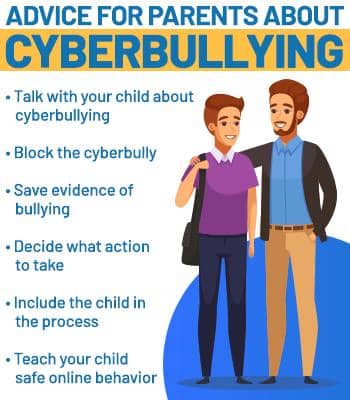 It is not possible to completely prevent the risk of cyberbullying. In 2015, teens spent up to nine hours a day using electronic devices (including streaming music and videos). Even if individuals stay off social media entirely, cyberbullies can still text other people about those individuals or set up fake accounts in their names.
It is not possible to completely prevent the risk of cyberbullying. In 2015, teens spent up to nine hours a day using electronic devices (including streaming music and videos). Even if individuals stay off social media entirely, cyberbullies can still text other people about those individuals or set up fake accounts in their names.
Parents can play important, preventive roles in minimizing these risks, such as:
- Describing cyberbullying to their children: what it is, how to recognize it, and why it’s wrong to engage in it.
- Encouraging communication—both talking with and listening to—their children.
- Explaining that they should not spread hurtful information or gossip because it might make them a cyberbully and a target for retaliation.
- Being understanding. If parents do not give their children the feeling that they can come forward with questions or concerns, they might not.
- Trying to learn about what their children do online. If parents know what sites their children are visiting and what they post on social media, they may be able to protect them from cyberbullying. Parental control apps can do this unobtrusively.
- Setting ground rules for online activity. Children need boundaries, even if they aren’t rigorously defined.
Having the support and friendship of peers is also a protective factor against online victimization.
Advice for Parents on Cyberbullying
When cyberbullying is suspected, detected, or reported, do not react immediately or respond in kind. Instead, take a deep breath and consider a more moderate approach:
- Talk with your child about cyberbullying. Even if parents have monitoring apps, children still know more about how cyberbullying has affected them. Understanding is necessary to correct any harm.
- Block the cyberbully. On most social media, you can choose not to receive messages from specific accounts. If the cyberbully finds your child on a forum or in a chatroom, leave. If the cyberbully has violated the terms of service for a site, report them to the moderator.
- Save evidence. Parents should preserve evidence as soon as they discover it. They can take screenshots of incriminating pages before a cyberbully or moderator deletes them. Parental control apps can help save evidence.
- Decide what needs doing. Children and parents must work together to respond to cyberbullying. It is usually more important to end cyberbullying than to punish it.
- Include children in the process. To restore a sense of safety and self-esteem for their children, parents should include them in their discussions. Together, parents and children can decide on responses that minimize the impact but do not escalate it.
- Teach your child safe online behavior. Practicing such behavior may protect against further cyberbullying.
As with most complex problems, no one solution is correct for all cases of cyberbullying.
When physical or psychological harm has occurred, legal action may be necessary.
If mental health or substance use disorders develop, seek proper psychological and medical treatment.
Cyberbullying Resources for Parents
Medical disclaimer:
Sunshine Behavioral Health strives to help people who are facing substance abuse, addiction, mental health disorders, or a combination of these conditions. It does this by providing compassionate care and evidence-based content that addresses health, treatment, and recovery.
Licensed medical professionals review material we publish on our site. The material is not a substitute for qualified medical diagnoses, treatment, or advice. It should not be used to replace the suggestions of your personal physician or other health care professionals.
